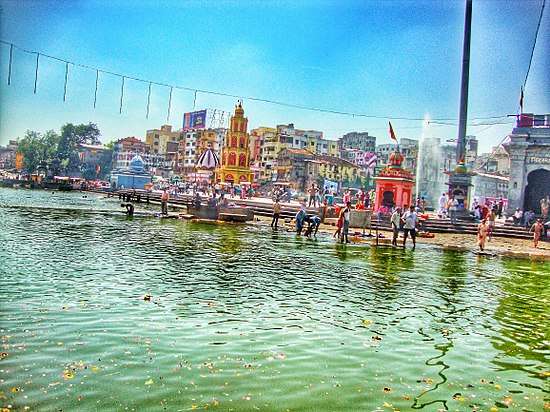Nashik
Nashik (/ˈnʌʃɪk/ also called as Nasik (![]()
Nashik Nasik | |
|---|---|
  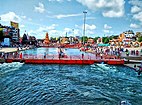  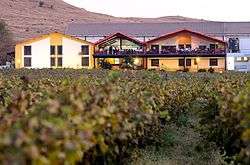    Clockwise from top left: Trimbakeshwar Shiva Temple, Anjaneri waterfall, Pandavleni Caves, Kalaram Temple, Nashik city skyline, Nashik grapes, Sula Vineyards, Godavari Ghat | |
| Nickname(s): Wine Capital of India[1] | |
 Nashik Location of Nasik in Maharashtra  Nashik Nashik (India) | |
| Coordinates: 20.00°N 73.78°E | |
| Country | |
| State | Maharashtra |
| District | Nashik |
| Government | |
| • Type | Municipal Corporation |
| • Mayor | Satish Kulkarni |
| • Guardian Minister | Chhagan Bhujbal |
| • Municipal Commissioner | Radhakrishna Game |
| • Commissioner of Police | Vishwas Nangare Patil |
| Area | |
| • Metropolis | 2,681 km2 (1,035 sq mi) |
| Elevation | 986 m (3,235 ft) |
| Population (2011)[2] | |
| • Metropolis | 1,486,973 (3rd in Maharashtra) |
| • Metro | 15,62,769 |
| • Metro rank | 10th |
| Demonym(s) | Nashikkar, Nashikites |
| Language | |
| • Official | Marathi |
| Time zone | UTC+5:30 (IST) |
| PIN | 422 0xx |
| Telephone code | 91(253) |
| Vehicle registration | MH-15(Nashik City) MH-41,51(Nashik Rural) |
| Website | nashik nashikcorporation www |
The city located about 190 km north of state capital Mumbai, is called the "Wine Capital of India" as half of India's vineyards and wineries are located in Nashik.[1][7]
Etymology
As per Ramayana, Nashik is the location on the banks of Godavari river where Laxman, by the wish of Lord Rama, cut the nose of Shurpanakha and thus this city was named as "Nashik".[6]
History
Geography
Nashik lies in the northern part of Maharashtra state at 584 m (1,916 ft)[8] from the mean sea level which gives it ideal temperature variation, particularly in winters.[1]
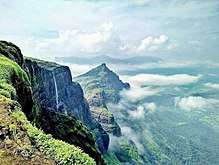
The river Godavari originates from the Brahmagiri Mountain, Trimbakeshwar about 24 km (15 mi) from Nashik and flows through the old residential settlement, now in the central part of the city. Due to high pollution created by factories in proximity of the city the river was dying at an alarming rate. It has since been successfully cleaned.[9]
Nashik lies on the western edge of the Deccan Plateau which is an ancient volcanic formation.[10]
Trimbakeshwar is about 30 km (19 mi) from the city, it is where from river Godavari originates. The land area of the city is about 259.13 km2 (100.05 sq mi).[11] Anjaneri near Nashik is traditionally considered the birthplace of Hanuman.
Climate
The city's tropical location and high altitude combine to give it a relatively mild version of a tropical wet and dry climate. Temperatures rise slightly in October, but this is followed by the cool season from November to February. The cool season sees warm temperatures of around 28 °C during the day, but cool nights, with lows averaging 10 °C, and extremely dry air.
| Climate data for Nashik (Ozar Airport) 1981–2010, extremes 1965–2006 | |||||||||||||
|---|---|---|---|---|---|---|---|---|---|---|---|---|---|
| Month | Jan | Feb | Mar | Apr | May | Jun | Jul | Aug | Sep | Oct | Nov | Dec | Year |
| Record high °C (°F) | 35.5 (95.9) |
38.6 (101.5) |
40.4 (104.7) |
42.4 (108.3) |
43.9 (111.0) |
43.3 (109.9) |
35.4 (95.7) |
34.3 (93.7) |
36.5 (97.7) |
38.5 (101.3) |
34.7 (94.5) |
33.4 (92.1) |
43.9 (111.0) |
| Average high °C (°F) | 29.3 (84.7) |
31.5 (88.7) |
35.2 (95.4) |
37.6 (99.7) |
37.6 (99.7) |
33.1 (91.6) |
28.8 (83.8) |
27.7 (81.9) |
29.6 (85.3) |
31.9 (89.4) |
30.7 (87.3) |
29.1 (84.4) |
31.8 (89.2) |
| Average low °C (°F) | 10.4 (50.7) |
12.0 (53.6) |
15.8 (60.4) |
19.3 (66.7) |
21.9 (71.4) |
22.7 (72.9) |
22.0 (71.6) |
21.2 (70.2) |
20.4 (68.7) |
17.7 (63.9) |
13.7 (56.7) |
10.7 (51.3) |
17.3 (63.1) |
| Record low °C (°F) | 0.4 (32.7) |
0.6 (33.1) |
5.7 (42.3) |
9.4 (48.9) |
13.5 (56.3) |
18.4 (65.1) |
17.0 (62.6) |
17.0 (62.6) |
13.5 (56.3) |
9.8 (49.6) |
5.0 (41.0) |
2.2 (36.0) |
0.4 (32.7) |
| Average rainfall mm (inches) | 2.4 (0.09) |
0.1 (0.00) |
0.3 (0.01) |
6.2 (0.24) |
24.5 (0.96) |
135.9 (5.35) |
156.1 (6.15) |
137.0 (5.39) |
131.5 (5.18) |
63.3 (2.49) |
17.9 (0.70) |
3.3 (0.13) |
678.4 (26.71) |
| Average rainy days | 0.2 | 0.0 | 0.1 | 0.7 | 1.4 | 6.7 | 12.0 | 10.4 | 8.3 | 3.6 | 1.1 | 0.3 | 44.8 |
| Average relative humidity (%) (at 17:30 IST) | 30 | 23 | 17 | 19 | 30 | 58 | 76 | 80 | 73 | 49 | 39 | 35 | 44 |
| Source: India Meteorological Department[12][13] | |||||||||||||
Civic administration
Nashik city is governed by the Nashik Municipal Corporation.[14]
Court
The Nashik Court Building is built in black stone in British regime style and a new building was inaugurated on 18 September 2005. There are 73 courts including taluka court.[15][16]
Solid waste management
In the Nashik Municipal Corporation area about 225 MT of solid waste is generated per day. Unlike other Indian cities, this garbage is collected by vehicles titled 'Ghantagadi' (meaning the vehicle with a bell): a system which has resulted in smaller versions of the ghantagadi ply in the congested old city areas. A plant has been set by the Nashik Municipal Corporation near Pandav Leni (Pandavleni Caves) to process the garbage and convert into compost.[17]
Demographics
Nashik is the fourth largest city in Maharashtra in terms of population after Mumbai, Pune and Nagpur. According to the Census of India, 2011, Nashik had a population of 1,486,053. Males constitute 782,517 of the population and females 703,536. Metropolitan Nashik population was 1,561,809 in which 821,921 were males and 739,888 were females. Nashik city had an average literacy rate of 89.85%: male literacy was 93.40%, and female literacy was 85.92%.[18]
The sex ratio is 894 per 1,000 males for Nashik city. Child sex ratio is 865 girls per 1,000 boys. In Nashik, 11.42% of the population is under 6 years of age.[19] In census year 2001 the Nashik Urban Agglomeration had a population of 11,52,326. Thus it was the fourth largest urban area of Maharashtra State after Mumbai, Pune and Nagpur. The projected population of Nashik urban agglomeration (which includes abutting urban areas like Deolali) as on 11 November 2012 is 15,62,769.[20]
Art and culture
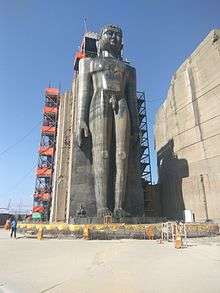
In February 2016, The Statue of Ahimsa, a 108 ft idol of first Jain tirthankara Rishabhdev carved in monolithic stone was consecrated at Mangi Tungi. It is recorded in the Guinness Book of World Records as the tallest Jain idol in the world.[22]
.jpg)
Pandavleni Caves
The Pandavleni Caves, or Nasik Caves, are a group of 24 caves carved between the 1st century BCE and the 2nd century CE,[23] representing the Hinayana Buddhist caves and. Most of the caves are Viharas except for the 18th cave which is a Chaitya.[24] The location of the caves is a holy Buddhist site and is located about 8 km south of Nashik.
Dams
- Gangapur Dam is on the river Godavari near Gangawadi village and it is earthen dam, Nashik.[25]
- Chankapur dam which is on the Girna river is one of the big dams built by the British in the 19th century. It is 3 km from the village Abhona in Kalwan tehsil and 60 km from Nashik.
- Kashypi Dam is on the Kashypi river near Rajapur, Nashik.
- Girna Dam is an earthfill type of dam on river Girna near Nandgaon, Nashik District.
- Darna Dam is a gravity dam on Darna river near Igatpuri, Nashik district.
Kumbh Mela
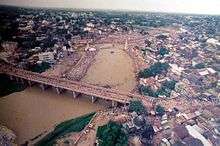
The Kumbh Mela is celebrated every six years at Haridwar and Allahabad and Maha Kumbh takes place every twelve years at four places in Allahabad, Haridwar, Ujjain, and Nashik. According to the Puranas, it is believed that Kumbh derives its name from an immortal pot of nectar, which the devtas (Gods) and demons fought over. The four places where the nectar fell are at the banks of river Godavari in Nashik, river Kshipra in Ujjain, river Ganges in Haridwar and at Triveni Sangam of Ganga, Yamuna and invisible Saraswati River in Allahabad.[26][5]
Economy
Agriculture

In early 1925, the table grape revolution was started in Ojhar, a small town near Nashik, by Raosaheb Jairam Krishna Gaikwad. Today, table grapes are exported to Europe, the Middle East, and Asia.[27]
The average Kharip crop area is 663,200 hectares while the average Rabbi crop area is 136500 hectares. The sown area is 658,763 hectares (99%) and the forest land is 340,000 hectares (21.75%). The uncultivable area is 23,000 hectares (1.48%).[28]
Industry
The Igatpuri-Nashik-Sinnar investment region is an important node in the US$90 billion Delhi Mumbai Industrial Corridor Project.[29][30]
Nashik is a defense and aerospace manufacturing hub with Hindustan Aeronautics Limited aircraft manufacturing plant located at Ozar.[31] The Currency Note Press[32] and India Security Press are on Nashik Road, where Indian currency and government stamp papers are printed respectively.[33]
Existing industrial areas in Nashik district are Satpur, Ambad, Sinnar, Igatpuri, Dindori and Vinchur. The proposed additional areas are Sinnar, Malegaon and Rajur Bahula.[34]
Large-scale industries present in Nashik district are Atlas Copco, Robert Bosch GmbH, CEAT Limited, Crompton Greaves, Graphite India, Schneider Electric, ThyssenKrupp, Epcos, Everest Industries, Gabriel India, GlaxoSmithKline, Hindustan Coca-Cola, Hindustan Unilever Limited, Jindal Polyster, Jyoti Structures, Kirlosker Oil Engines, KSB Pumps, Larsen & Toubro, Mahindra and Mahindra, Mahindra Sona, United Spirits Limited, Perfect Circle Industries, Mahindra Ugine Steel, Samsonite, Shalimar Paints, Siemens, VIP Industries, Indian Oil Corporation, XLO India Limited and Jindal Saw.[35]
Apart from manufacturing, Nashik is an emerging investment destination for Information Technology companies. Tata Consultancy Services has invested in Nashik under the government of India BPO promotion scheme (IBPS). Also WNS, ACRESS, Accenture, ICOMET technoloies[36] TCS has set up Digital Impact Square, or DISQ, which is a social innovation center.[37]
Nashik has a textile industry.[8] National Bank for Agriculture and Rural Development has selected Yeola Block for development of Paithani Cluster.[8] To facilitate exports, a container freight station was started at MIDC Ambad by the Central Government.[38]
Wine industry

Nashik has been described as "The Wine Capital of India" the Nashik region reportedly produced 10,000 tonnes of grapes per year.[39]
In 2013, there were 22 wineries in Nashik, out of 46 wineries throughout India.[40] The largest vineyard in Nashik is the Sula Vineyards.[1]
In the harvest season, Nashik is home to several wine festivals, such as the India Grape Harvest and SulaFest.[41][42]
Education
The city has two state-run universities: the Yashwantrao Chavan Maharashtra Open University and the Maharashtra University of Health Sciences.
Transport
- Roadways- Nashik is connected to others cities in India by road.
- Railways- Nasik Road railway station is city railway station along with Deolali which lies within the city boundary.
- Airways- Nashik has its airport located at Ozar and an old airport at Gandhinagar which connected Nashik to Mumbai. The Gandhinagar Airport is now served for the military. Nashik Airport is domestic airport and it is connected to Ahmedabad, Indore and Hyderabad. Soon the city will be connected to Bengaluru and Goa under the UDAN scheme. There also had been a sea port constructed on Gangapur Dam to connect to Pune and Mumbai via a seaplane service which was operated by MEHAIR.
- Public Transport- In city people often mostly prefer auto rickshaw to travel. City bus service is operated by MSRTC.
- Metro - Greater Nashik Metro is proposed by Maharashtra Metro Rail Corporation Limited. It will be operational in 2024.
Notable people
- Arjun Rampal, Actor
- Arshad Warsi, Actor
- Dilip Kumar, Actor
- Vinod Khanna, Actor
- Bhumika Chawla, Actress
- Abhishek Raut, Cricketer
- Anant Laxman Kanhere, Indian independence fighter
- Anjana Thamke, Athlete
- Dadasaheb Phalke, father of Indian cinema
- Pandit Dattatreya Vishnu Paluskar, Hindustani classical vocalist
- Vinayak Damodar Savarkar[44] Indian pro-independence activism, politician, poet, writer and playwright
- Kusumagraj (Vishnu Vāman Shirwādkar), Marathi poet, playwright, and novelist
- Shivaji Tupe, Painter
- Krishnaji Gopal Karve, Indian freedom fighter, revolutionary
- Tatya Tope, Leader in the Indian Rebellion of 1857
- Dhairya Dand, Inventor, artist, designer
- Kavita Raut, Long-distance runner
- Sunil Khandbahale, Innovator, entrepreneur, language enthusiast[45][46]
- Dattaraya Ramchandra Kaprekar, Recreational mathematician)
- Sayali Bhagat Femina Miss India world 2004, model/actress
- Mahadev Govind Ranade, (18 January 1842 – 16 January 1901) a distinguished Indian scholar, social reformer and author
- Ramesh Raskar, Computer scientist
- Dattu Baban Bhokanal, Rower
- Chinmay Udgirkar, Actor
- Vidit Santosh Gujrathi, Indian chess player
- Dadasaheb Gaikwad (Bhaurao Krishnaji Gaikwad), a politician, social worker
- Uttara Mhatre Kher Former Miss India
- Saiyami Kher Actress
- Anjali Patil Actress
- Shashank Khaitan Director
References
- "Why Nashik is the wine capital of India - Asia-Pacific - RFI". 25 September 2016. Archived from the original on 9 April 2018. Retrieved 9 April 2018.
- "Cities having population 1 lakh and above" (PDF). Census of India 2011. The Registrar General & Census Commissioner, India. Archived (PDF) from the original on 23 July 2013. Retrieved 29 December 2012.
- "Major Agglomerations" (PDF). censusindia.gov.in. Archived (PDF) from the original on 17 October 2013. Retrieved 25 January 2014.
- "jjkent.com". jjkent.com. Archived from the original on 27 January 2013. Retrieved 28 September 2013.
- "History of Kumbh Mela – Origin of Kumbh Mela". Kumbhamela.net. Archived from the original on 18 September 2018. Retrieved 2 July 2015.
- "Development and present Status of Nashik District" (PDF). Archived (PDF) from the original on 9 April 2018. Retrieved 9 April 2018.
- "Visit Nashik, Wine Capital of India". CNN. 14 November 2017. Archived from the original on 9 April 2018. Retrieved 9 April 2018.
- "Overview of District". Official Website of Nashik District. Nashik.nic.in. Archived from the original on 5 April 2015. Retrieved 1 February 2015.
- "geography". Archived from the original on 18 January 2019. Retrieved 21 April 2019.
- "Official WebSite of District". Nashik.nic.in. Archived from the original on 16 July 2011. Retrieved 16 July 2010.
- "History of Nashik". Nashikcorporation.com. Archived from the original on 27 December 2008. Retrieved 16 July 2010.
- "Station: Ozar (A) Climatological Table 1981–2010" (PDF). Climatological Normals 1981–2010. India Meteorological Department. January 2015. pp. 577–578. Archived from the original (PDF) on 5 February 2020. Retrieved 10 April 2020.
- "Extremes of Temperature & Rainfall for Indian Stations (Up to 2012)" (PDF). India Meteorological Department. December 2016. p. M149. Archived from the original (PDF) on 5 February 2020. Retrieved 10 April 2020.
- "Nashik Municipal Corporation :: Nashik Municipal Corporation". nashikcorporation.in. Archived from the original on 13 January 2019. Retrieved 21 April 2019.
- "History - Official Website of District Court Of India". Archived from the original on 10 September 2015. Retrieved 24 August 2015.
- "Nashik district court: Latest News, Videos and Photos of Nashik district court - Times of India". The Times of India. Archived from the original on 16 January 2019. Retrieved 10 January 2019.
- "Concept Paper on Preparation of City Development Plan For Three Cities of Jharkhand Under Jawaharlal Nehru Urban Renewal Missi" (PDF). Archived from the original (PDF) on 4 March 2009. Retrieved 16 July 2010.
- "2011 Census Nashik". India 2011 Census. Archived from the original on 8 July 2018. Retrieved 21 April 2019.
- "Nashik City Population Census 2011 – Maharashtra". Archived from the original on 3 July 2015. Retrieved 27 July 2015.
- Thomas Brinkhoff (23 January 2010). "The Principal Agglomerations of the World – Population Statistics & Maps". Citypopulation.de. Archived from the original on 4 July 2010. Retrieved 16 July 2010.
- "Nashik City Census 2011 data". Archived from the original on 4 May 2018. Retrieved 19 May 2018.
- "Guinness Book to certify Mangi Tungi idol - Times of India". The Times of India. Archived from the original on 7 February 2018. Retrieved 17 April 2018.
- Empires: Perspectives from Archaeology and History by Susan E. mouurya p.168
- lonelyplanet
- "Official WebSite of Nashik District". Archived from the original on 10 August 2013. Retrieved 27 July 2015.
- "Official WebSite of Nashik District". Nashik.nic.in. Archived from the original on 6 April 2015. Retrieved 2 July 2015.
- Tushar Pawar, TNN 16 May 2012, 06.06AM IST (16 May 2012). "India's grape export up by nearly 60% this year – Times of India". Articles.timesofindia.indiatimes.com. Retrieved 28 September 2013.CS1 maint: multiple names: authors list (link)
- "Official Website of Nashik District". Nashik.nic.in. 31 October 2012. Archived from the original on 1 July 2015. Retrieved 2 July 2015.
- "Delhi-Mumbai Industrial Corridor launched in Maharashtra". Financial Express. 4 March 2014. Archived from the original on 14 January 2018. Retrieved 13 January 2018.
- Khapre, Shubhangi (10 February 2018). "Magnetic Maharashtra: Delhi-Mumbai industrial corridor to be showcased". Indian Express. Archived from the original on 19 May 2018. Retrieved 19 May 2018.
- "Welcome to HAL – Aircraft Division". Archived from the original on 23 March 2013.
- "Currency Note Press, Nashik has Highest Ever Monthly Production of 451.5 Million Pieces (MPCS) of Banknotes during January, 2013". Press Information Bureau, Government of India. 8 February 2013. Archived from the original on 7 February 2019. Retrieved 21 April 2019.
- "CNPN Home". Cnpnashik.spmcil.com. 21 October 2010. Archived from the original on 27 June 2013. Retrieved 28 September 2013.
- "MSME Nashik report" (PDF). dcmsme.gov.in. Archived (PDF) from the original on 9 August 2017. Retrieved 8 August 2017.
- "Brief Industrial Profile of Nashik District" (PDF). GOI Ministry of MSME. 2017. Archived (PDF) from the original on 9 August 2017. Retrieved 8 August 2017.
- Market, Capital (11 May 2017). "India BPO promotion scheme". Business Standard India. Archived from the original on 9 August 2017. Retrieved 9 August 2017.
- Layak, Suman (7 August 2016). "After Pune, Nashik is emerging as latest hub for tech startups in India". The Economic Times. Archived from the original on 11 August 2017. Retrieved 9 August 2017.
- "Industry". Official Website of Nashik District. Archived from the original on 6 April 2015.
- "Nashik Harvest". Food NDTV. Archived from the original on 8 December 2015. Retrieved 27 November 2015.
- Pawar, Tushar (13 December 2006). "Business Standard". Business Standard India. Business Standard. Archived from the original on 8 December 2015. Retrieved 27 November 2015.
- http://www.jamaicaobserver.com/lifestyle/Wines-from-Nashik---the-wine-capital-of-India_19223423.html
- "Leaders of Tomorrow: Nashik- The wine capital of India | The Economic Times Video | ET Now". Economictimes.indiatimes.com. Archived from the original on 3 August 2015. Retrieved 28 September 2013.
- "Maharashtra Tourism". Archived from the original on 29 July 2018. Retrieved 17 May 2018.
Budapest and Nashik to be sister cities as collaboration between Hungary and Maharashtra to have a roadmap ahead for mutual synergies!Shri Jaykumar Rawal, Hon Minister Tourism, Shri Vijay Gautam IAS PS, Shri Aashutosh Rathod JtMD, interacting with the Hungary delegation at Sahyadri
- "Veer Savarkar Biography - Vir Savarkar Indian Freedom Fighter - Vinayak Damodar Savarkar History". www.iloveindia.com. Archived from the original on 27 August 2015. Retrieved 11 September 2015.
- "Young Achievers". Indian Express. 11 November 2013. Archived from the original on 10 January 2015. Retrieved 5 January 2015.
- "Youth Icon". Maharashtra Times. 16 March 2013. Archived from the original on 17 November 2015. Retrieved 5 August 2013.
External links
| Wikimedia Commons has media related to Nashik. |
| Wikivoyage has a travel guide for Nashik. |
- Unravel Nashik, The City of Abundance
- . Encyclopædia Britannica (11th ed.). 1911.
- Nashik Municipal Corporation
